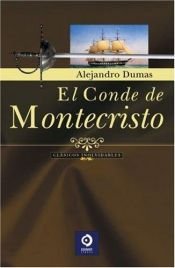El conde de Montecristo
Resumen
El conde de Montecristo es una novela de aventuras clásica de Alexandre Dumas padre y Auguste Maquet. Éste último no figuró en los títulos de la obra ya que Alexandre Dumas pagó una elevada suma de dinero para que así fuera. Maquet era un colaborador muy activo en las novelas de Dumas, llegó a escribir obras enteras que Dumas reescribió más tarde. Esta obra se suele considerar como el mejor trabajo de Dumas, y a menudo se incluye en las listas de las mejores novelas de todos los tiempos. El libro se terminó de escribir en 1844, y fue publicado en una serie de 18 partes durante los dos años siguientes.La historia tiene lugar en Francia, Italia y varias islas del Mediterráneo durante los hechos históricos de 1814–1838. Trata sobre todo los temas de la justicia, la venganza, la piedad y el perdón y está contada en el estilo de una historia de aventuras.
Dumas obtuvo la idea principal de una historia real que encontró en las memorias de un hombre llamado Jacques Peuchet. Peuchet contaba la historia de un zapatero llamado François Picaud que vivía en París en 1807.

 Español
Español English
English Deutsch
Deutsch










Reseñas de los usuarias/os Escribe tu propia reseña
Alexandru.chereches
Inca o carte ce ne releva natura intunecata a umanitatii si a legilor umane.
Sé el/la primera/o en reseñar
Sciamatic
One the early adventure novels, 'Monte Cristo' shows its age. While a classic that should be read to understand the beginnings of a now popular genre, the book still suffers from what any progenitor suffers from: a lack of polish. The book contains an abundance of "As you know, Bob..." dialogue, in which two characters who are well familiar with a fact must still discuss it among themselves to let the audience in; or, alternately, dialogue in which the characters speak entirely unnaturally to assuage the audience of their perceptions. For example, the Count is lying about his age. We, the audience, know that. The characters he's deceiving, obviously don't. Rather than simple answer simply, when asked his age, the Count goes through verbal gymnastics to convince a character who has no reason to think he's lying that he isn't lying, because Dumas wants the audience to know that he's thought this all out. It's one of those things that you have to take into account when reading early versions of genre tales -- that the tropes and cliches weren't tropes and cliches yet, and no one knew, or even thought, to avoid them. To me, this makes 'The Count of Monte Cristo' a must read for people wanting to experience the evolution of novel-style story telling, but I don't think this necessarily removes my critique of the writing. While the cliches weren't cliches yet, that doesn't absolve the author of certain crimes. After all, surely Dumas was aware of how people spoke to one another, yet often his characters more woodenly go through puppet plays for his own delight than speaking in any kind of organic manner. In short, I'm very glad to have read this book, and would recommend it to lover's of books, but it is still a bit of a trial to get through, and lacks the charm of other books of the same era.
Sé el/la primera/o en reseñar
Paula
Genialer Klassiker
Sé el/la primera/o en reseñar
Pwtierney
Dumas weaves an incredible story. It isn't difficult or especially deep reading; it is a fun, and exciting adventure story meant to entertain more than enlighten. That said, it is done incredibly well, and I'd recommend it for anyone interested in the classical "canon" of adventure novels.
Sé el/la primera/o en reseñar
Mandavi
Durchaus spannende Geschichte über die großen und reinen Gefühle. Andererseits doch sehr schwarz -weiß und irgendwie recht vorhersehbar, was mich aber nicht vom Mitfiebern abhalten konnte. Und das, nahezu über den ganzen, doch recht beachtlichen Wälzer ;)
Sé el/la primera/o en reseñar